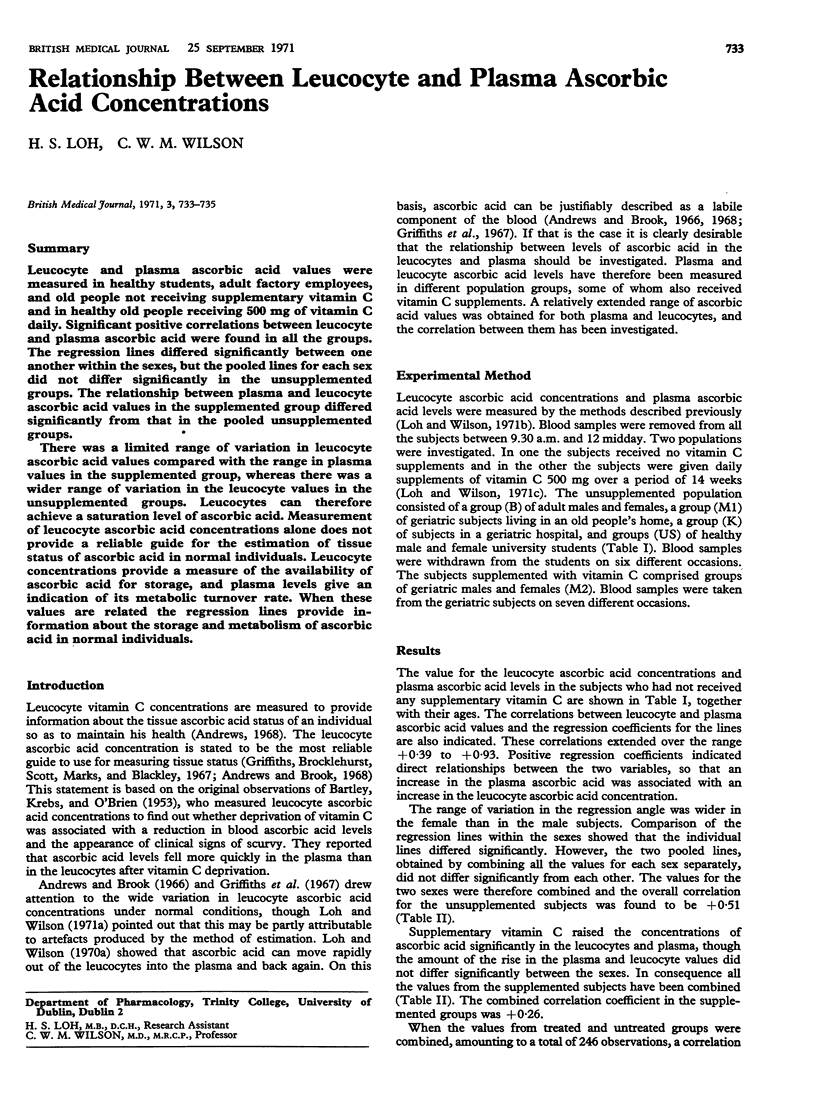Abstract
Leucocyte and plasma ascorbic acid values were measured in healthy students, adult factory employees, and old people not receiving supplementary vitamin C and in healthy old people receiving 500 mg of vitamin C daily. Significant positive correlations between leucocyte and plasma ascorbic acid were found in all the groups. The regression lines differed significantly between one another within the sexes, but the pooled lines for each sex did not differ significantly in the unsupplemented groups. The relationship between plasma and leucocyte ascorbic acid values in the supplemented group differed significantly from that in the pooled unsupplemented groups.
There was a limited range of variation in leucocyte ascorbic acid values compared with the range in plasma values in the supplemented group, whereas there was a wider range of variation in the leucocyte values in the unsupplemented groups. Leucocytes can therefore achieve a saturation level of ascorbic acid. Measurement of leucocyte ascorbic acid concentrations alone does not provide a reliable guide for the estimation of tissue status of ascorbic acid in normal individuals. Leucocyte concentrations provide a measure of the availability of ascorbic acid for storage, and plasma levels give an indication of its metabolic turnover rate. When these values are related the regression lines provide information about the storage and metabolism of ascorbic acid in normal individuals.
Full text
PDF


Selected References
These references are in PubMed. This may not be the complete list of references from this article.
- Andrews J., Brook M. Leucocyte-vitamin-C content and clinical signs in the elderly. Lancet. 1966 Jun 18;1(7451):1350–1351. doi: 10.1016/s0140-6736(66)92139-8. [DOI] [PubMed] [Google Scholar]
- Andrews J., Fairley A., Barker R. Total dose infusion of iron-dextran in the elderly. Scott Med J. 1967 Jun;12(6):208–215. doi: 10.1177/003693306701200602. [DOI] [PubMed] [Google Scholar]
- Andrews J., Letcher M., Brook M. Vitamin C supplementation in the elderly: a 17-month trial in an old persons' home. Br Med J. 1969 May 17;2(5654):416–418. doi: 10.1136/bmj.2.5654.416. [DOI] [PMC free article] [PubMed] [Google Scholar]
- Brocklehurst J. C., Griffiths L. L., Taylor G. F., Marks J., Scott D. L., Blackley J. The clinical features of chronic vitamin deficiency. A therapeutic trial in geriatric hospital patients. Gerontol Clin (Basel) 1968;10(5):309–320. doi: 10.1159/000245198. [DOI] [PubMed] [Google Scholar]
- Brook M., Grimshaw J. J. Vitamin C concentration of plasma and leukocytes as related to smoking habit, age, and sex of humans. Am J Clin Nutr. 1968 Nov;21(11):1254–1258. doi: 10.1093/ajcn/21.11.1254. [DOI] [PubMed] [Google Scholar]
- Cohen M. M., Duncan A. M. Ascorbic acid nutrition in gastroduodenal disorders. Br Med J. 1967 Dec 2;4(5578):516–518. doi: 10.1136/bmj.4.5578.516. [DOI] [PMC free article] [PubMed] [Google Scholar]
- Dodds M. L. Sex as a factor in blood levels of ascorbic acid. J Am Diet Assoc. 1969 Jan;54(1):32–33. [PubMed] [Google Scholar]
- LOWRY O. H., BESSEY O. A., BURCH H. B. Effects of prolonged high dosage with ascorbic acid. Proc Soc Exp Biol Med. 1952 Jun;80(2):361–362. doi: 10.3181/00379727-80-19623. [DOI] [PubMed] [Google Scholar]
- Loh H. S., Wilson C. W. The origin of ascorbic acid stored in the leucocytes. Br J Pharmacol. 1970 Sep;40(1):169P–170P. [PMC free article] [PubMed] [Google Scholar]
- Loh H. S., Wilson C. W. The relationship between leucocyte ascorbic acid and plasma iron. Br J Pharmacol. 1970 Nov;40(3):566P–567P. [PMC free article] [PubMed] [Google Scholar]
- Sahud M. A., Cohen R. J. Effect of aspirin ingestion on ascorbic-acid levels in rheumatoid arthritis. Lancet. 1971 May 8;1(7706):937–938. doi: 10.1016/s0140-6736(71)91441-3. [DOI] [PubMed] [Google Scholar]


